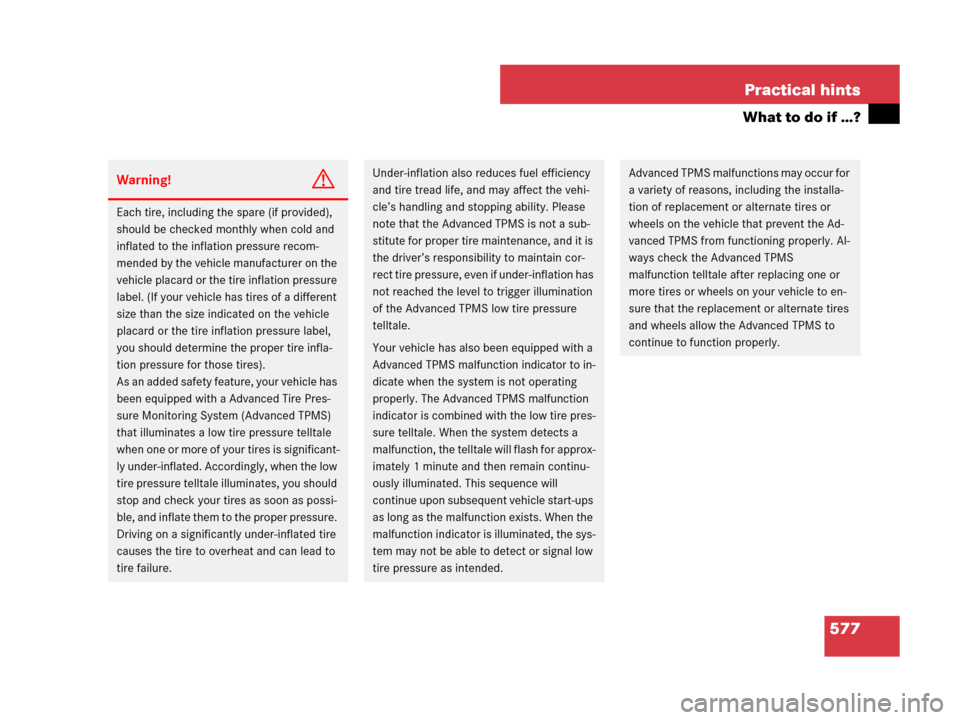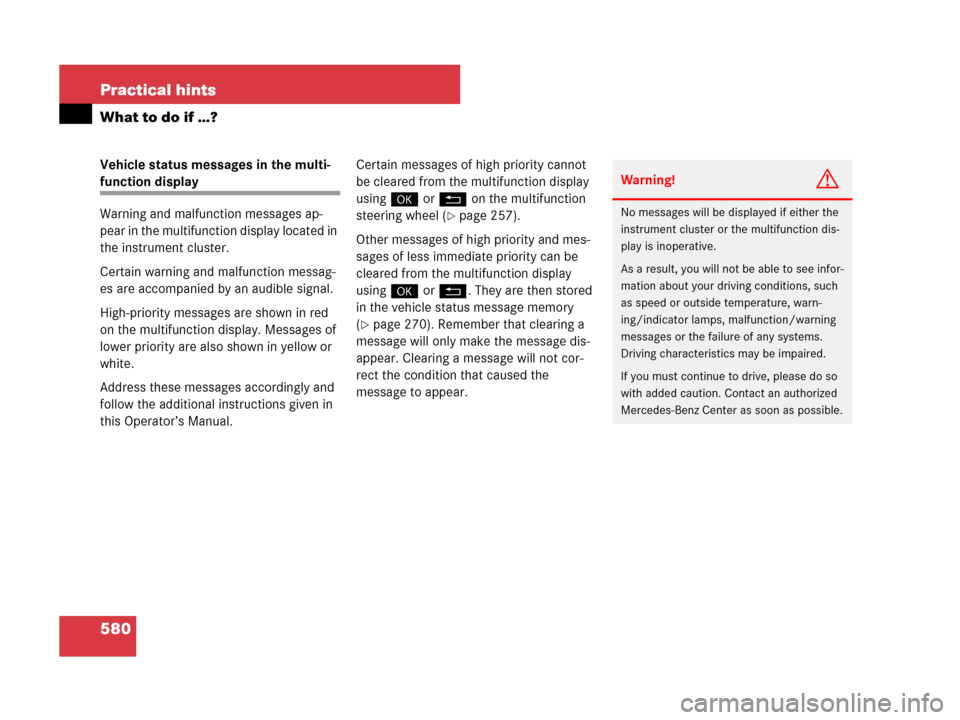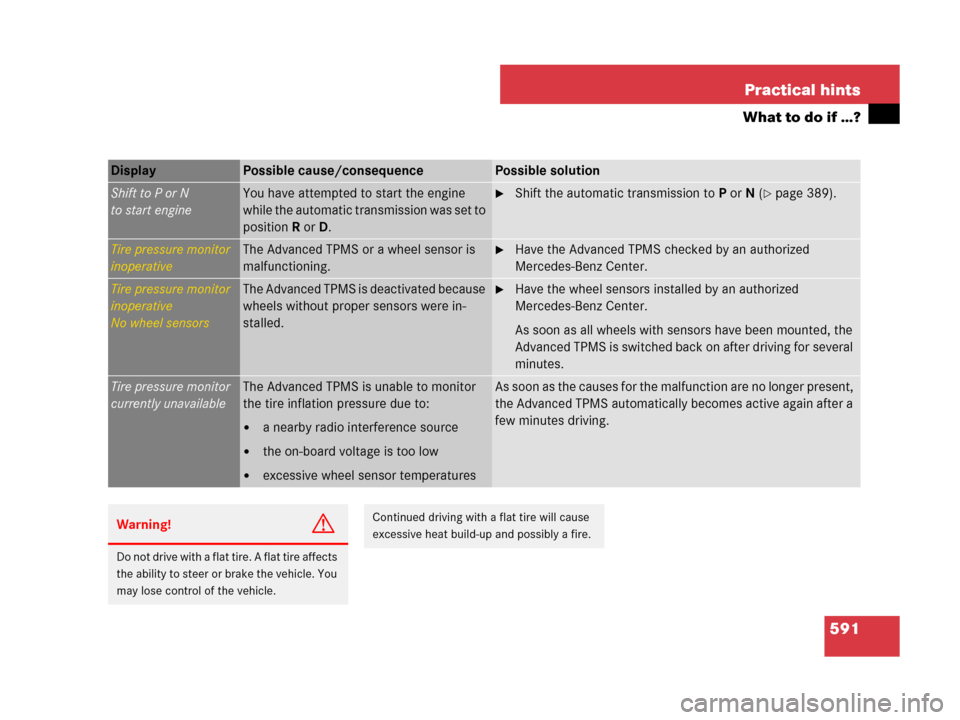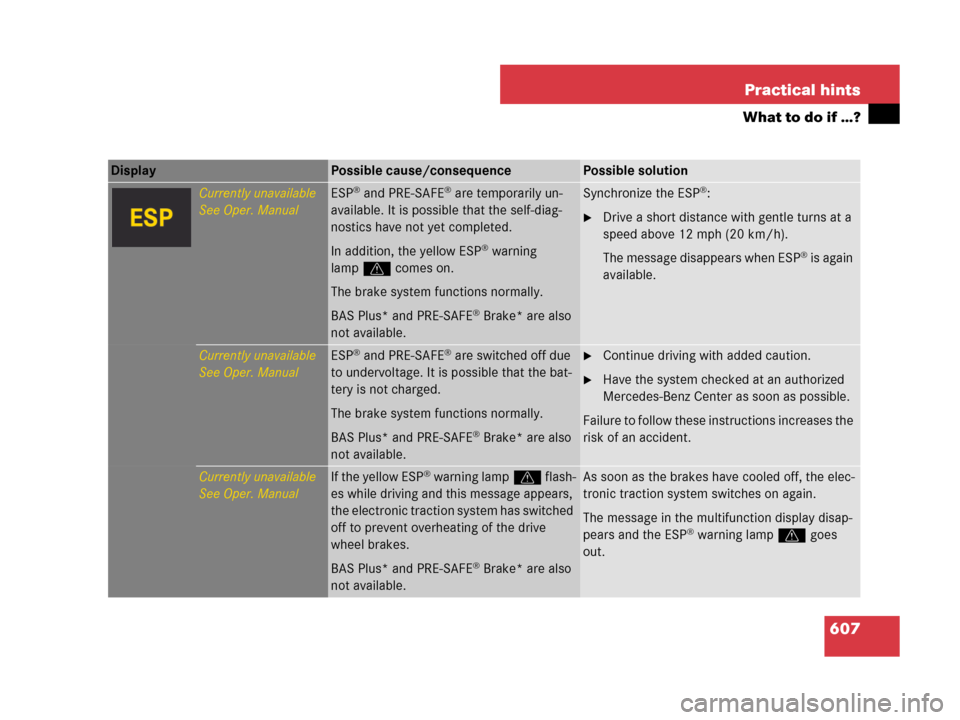Page 580 of 723

577 Practical hints
What to do if …?
Warning!G
Each tire, including the spare (if provided),
should be checked monthly when cold and
inflated to the inflation pressure recom-
mended by the vehicle manufacturer on the
vehicle placard or the tire inflation pressure
label. (If your vehicle has tires of a different
size than the size indicated on the vehicle
placard or the tire inflation pressure label,
you should determine the proper tire infla-
tion pressure for those tires).
As an added safety feature, your vehicle has
been equipped with a Advanced Tire Pres-
sure Monitoring System (Advanced TPMS)
that illuminates a low tire pressure telltale
when one or more of your tires is significant-
ly under-inflated. Accordingly, when the low
tire pressure telltale illuminates, you should
stop and check your tires as soon as possi-
ble, and inflate them to the proper pressure.
Driving on a significantly under-inflated tire
causes the tire to overheat and can lead to
tire failure.
Under-inflation also reduces fuel efficiency
and tire tread life, and may affect the vehi-
cle’s handling and stopping ability. Please
note that the Advanced TPMS is not a sub-
stitute for proper tire maintenance, and it is
the driver’s responsibility to maintain cor-
rect tire pressure, even if under-inflation has
not reached the level to trigger illumination
of the Advanced TPMS low tire pressure
telltale.
Your vehicle has also been equipped with a
Advanced TPMS malfunction indicator to in-
dicate when the system is not operating
properly. The Advanced TPMS malfunction
indicator is combined with the low tire pres-
sure telltale. When the system detects a
malfunction, the telltale will flash for approx-
imately 1 minute and then remain continu-
ously illuminated. This sequence will
continue upon subsequent vehicle start-ups
as long as the malfunction exists. When the
malfunction indicator is illuminated, the sys-
tem may not be able to detect or signal low
tire pressure as intended.Advanced TPMS malfunctions may occur for
a variety of reasons, including the installa-
tion of replacement or alternate tires or
wheels on the vehicle that prevent the Ad-
vanced TPMS from functioning properly. Al-
ways check the Advanced TPMS
malfunction telltale after replacing one or
more tires or wheels on your vehicle to en-
sure that the replacement or alternate tires
and wheels allow the Advanced TPMS to
continue to function properly.
Page 583 of 723

580 Practical hints
What to do if …?
Vehicle status messages in the multi-
function display
Warning and malfunction messages ap-
pear in the multifunction display located in
the instrument cluster.
Certain warning and malfunction messag-
es are accompanied by an audible signal.
High-priority messages are shown in red
on the multifunction display. Messages of
lower priority are also shown in yellow or
white.
Address these messages accordingly and
follow the additional instructions given in
this Operator’s Manual.Certain messages of high priority cannot
be cleared from the multifunction display
using# or L on the multifunction
steering wheel (
�page 257).
Other messages of high priority and mes-
sages of less immediate priority can be
cleared from the multifunction display
using# or L. They are then stored
in the vehicle status message memory
(
�page 270). Remember that clearing a
message will only make the message dis-
appear. Clearing a message will not cor-
rect the condition that caused the
message to appear.
Warning!G
No messages will be displayed if either the
instrument cluster or the multifunction dis-
play is inoperative.
As a result, you will not be able to see infor-
mation about your driving conditions, such
as speed or outside temperature, warn-
ing/indicator lamps, malfunction/warning
messages or the failure of any systems.
Driving characteristics may be impaired.
If you must continue to drive, please do so
with added caution. Contact an authorized
Mercedes-Benz Center as soon as possible.
Page 594 of 723

591 Practical hints
What to do if …?
Display Possible cause/consequencePossible solution
Shift to P or N
to start engineYou have attempted to start the engine
while the automatic transmission was set to
position R or D.�Shift the automatic transmission to P or N (�page 389).
Tire pressure monitor
inoperativeThe Advanced TPMS or a wheel sensor is
malfunctioning.�Have the Advanced TPMS checked by an authorized
Mercedes-Benz Center.
Tire pressure monitor
inoperative
No wheel sensorsThe Advanced TPMS is deactivated because
wheels without proper sensors were in-
stalled.�Have the wheel sensors installed by an authorized
Mercedes-Benz Center.
As soon as all wheels with sensors have been mounted, the
Advanced TPMS is switched back on after driving for several
minutes.
Tire pressure monitor
currently unavailableThe Advanced TPMS is unable to monitor
the tire inflation pressure due to:
�a nearby radio interference source
�the on-board voltage is too low
�excessive wheel sensor temperatures
As soon as the causes for the malfunction are no longer present,
the Advanced TPMS automatically becomes active again after a
few minutes driving.
Warning!G
Do not drive with a flat tire. A flat tire affects
the ability to steer or brake the vehicle. You
may lose control of the vehicle.
Continued driving with a flat tire will cause
excessive heat build-up and possibly a fire.
Page 596 of 723
593 Practical hints
What to do if …?
Symbol messages
Display Possible cause/consequencePossible solution
Malfunction
Stop Vehicle!You have started driving although the vehi-
cle level is still too low.
The vehicle is raised. The ABC message
goes out after a few seconds.�Stop your vehicle as soon as it is safe to do
so.
�Wait until the message disappears from the
multifunction display.
You may then drive off.
The vehicle is losing oil.
The ABC message is continuously shown.�Stop your vehicle as soon as it is safe to do
so.
�Call Roadside Assistance.
�Notify an authorized Mercedes-Benz Center.
ABC is malfunctioning.
The ABC message is continuously shown.�Do not turn steering wheel too far to avoid
damaging the front fenders.
�Listen for scraping noises.
�Do not exceed a speed of 50 mph (80 km/h).
�Contact an authorized Mercedes-Benz Cen-
ter as soon as possible.
Page 597 of 723

594 Practical hints
What to do if …?
Display Possible cause/consequencePossible solution
MalfunctionThe capability of the ABC system is restrict-
ed. This can impair the handling.�Do not exceed a speed of 50 mph (80 km/h).
�Contact an authorized Mercedes-Benz
Center as soon as possible.
Vehicle rising
Please wait a momentThe vehicle’s level is too low while at a
standstill. The vehicle will be raised.�Do not drive off.
�Wait until the message disappears from the
multifunction display.
You may then drive off.
ABS and ESP
inoperative
See Oper. ManualABS, ESP® as well as PRE-SAFE® are
switched off due to a malfunction. BAS is
also switched off.
The brake system is still functioning nor-
mally but without the ABS available.
BAS Plus* and PRE-SAFE
® Brake* are also
not available.
�Continue driving with added caution. Wheels
may lock during hard braking, reducing steer-
ing capability.
�Have the system checked at an authorized
Mercedes-Benz Center as soon as possible.
Failure to follow these instructions increases the
risk of an accident.
Page 610 of 723

607 Practical hints
What to do if …?
Display Possible cause/consequencePossible solution
Currently unavailable
See Oper. ManualESP® and PRE-SAFE® are temporarily un-
available. It is possible that the self-diag-
nostics have not yet completed.
In addition, the yellow ESP
® warning
lampv comes on.
The brake system functions normally.
BAS Plus* and PRE-SAFE
® Brake* are also
not available.
Synchronize the ESP®:
�Drive a short distance with gentle turns at a
speed above 12 mph (20 km/h).
The message disappears when ESP
® is again
available.
Currently unavailable
See Oper. ManualESP® and PRE-SAFE® are switched off due
to undervoltage. It is possible that the bat-
tery is not charged.
The brake system functions normally.
BAS Plus* and PRE-SAFE
® Brake* are also
not available.
�Continue driving with added caution.
�Have the system checked at an authorized
Mercedes-Benz Center as soon as possible.
Failure to follow these instructions increases the
risk of an accident.
Currently unavailable
See Oper. ManualIf the yellow ESP® warning lampv flash-
es while driving and this message appears,
the electronic traction system has switched
off to prevent overheating of the drive
wheel brakes.
BAS Plus* and PRE-SAFE
® Brake* are also
not available.
As soon as the brakes have cooled off, the elec-
tronic traction system switches on again.
The message in the multifunction display disap-
pears and the ESP
® warning lampv goes
out.
Page 631 of 723
628 Practical hints
What to do if …?
Display Possible cause/consequencePossible solution
Tele Aid
inoperativeOne or more main functions of the Tele Aid
system are malfunctioning.�Have the Tele Aid system checked by an
authorized Mercedes-Benz Center.
Tire pressure
Caution, tire defectAdvanced TPMS:
One or more tires are deflating.�Carefully bring the vehicle to a halt, avoiding
abrupt steering and braking maneuvers.
�If necessary, change the wheel (�page 649).
Caution
Tire defectAdvanced TPMS:
One or more tires are deflating. The respec-
tive tire is shown in the multifunction
display.�Carefully bring the vehicle to a halt, avoiding
abrupt steering and braking maneuvers.
�If necessary, change the wheel (�page 649).
Warning!G
Do not drive with a flat tire. A flat tire affects
the ability to steer or brake the vehicle. You
may lose control of the vehicle. Continued
driving with a flat tire will cause excessive
heat build-up and possibly a fire.
Page 632 of 723
629 Practical hints
What to do if …?
Display Possible cause/consequencePossible solution
Tire pressure
Check tiresAdvanced TPMS:
The pressure is too low in one or more tires.�Carefully bring the vehicle to a halt, avoiding
abrupt steering and braking maneuvers.
�Check and adjust tire inflation pressure as
required (
�page 534).
�If necessary, change the wheel (�page 534).
Check tiresAdvanced TPMS:
The pressure is too low in one or more tires.
The respective tire is shown in the multi-
function display.�Carefully bring the vehicle to a halt, avoiding
abrupt steering and braking maneuvers.
�Check and adjust tire inflation pressure as
required (
�page 534).
�If necessary, change the wheel (�page 534).
Warning!G
Do not drive with a flat tire. A flat tire affects
the ability to steer or brake the vehicle. You
may lose control of the vehicle. Continued
driving with a flat tire will cause excessive
heat build-up and possibly a fire.